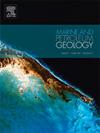Tectonic and climatic interplay controls organic matter enrichment in Eocene low-latitude rift lakes: Insights from the Asian continental margin
IF 3.7
2区 地球科学
Q1 GEOSCIENCES, MULTIDISCIPLINARY
引用次数: 0
Abstract
Organic matter enrichment in lacustrine rift basins remains enigmatic compared to marine systems, despite their significant role in global carbon cycling. The Eocene Liushagang Formation (South China Sea) provides valuable insight into how tectonic-climatic interactions control organic matter accumulation during active rifting. While conventional models emphasize productivity-anoxia interplay, the role of tectonic-climatic controls on organic matter deposition was less discussed. By integrating sedimentology, petrology, organic geochemistry, palynology, and elemental geochemistry, this multidisciplinary dataset seeks to elucidate the relationships between regional tectonism, climate change, and lake environment. Our results suggest that: (1) Intense rift activity, warm-humid climate, and moderate chemical weathering promoted a deep and stratified lake with high productivity and anoxia; (2) A distinct vertical variation in organic matter enrichment, with exceptional TOC contents in lower E2l2 shales contrasting sharply with diminished accumulation in upper E2l2 due to climate cooling and nutrient depletion; (3) Three predictive models of organic matter enrichment that correlate specific depositional conditions with accumulation efficiency. These results fundamentally advance our understanding of rift lake organic matter enrichment by highlighting tectonic accommodation space and Early Eocene Climatic Optimum (EECO) perturbations as primary drivers. The established models provide a valuable framework for evaluating lacustrine source rocks potential in Cenozoic basins worldwide, with particular relevance for low-latitude rift systems.
构造与气候相互作用控制始新世低纬度裂谷湖有机质富集:来自亚洲大陆边缘的启示
与海洋系统相比,湖泊裂谷盆地的有机质富集仍然是一个谜,尽管它们在全球碳循环中起着重要作用。南海始新世流沙港组为构造-气候相互作用如何控制活动裂谷期有机质聚集提供了有价值的认识。虽然传统模式强调生产力-缺氧的相互作用,但构造-气候控制对有机质沉积的作用讨论较少。通过整合沉积学、岩石学、有机地球化学、孢粉学和元素地球化学,该多学科数据集旨在阐明区域构造、气候变化和湖泊环境之间的关系。结果表明:(1)强烈的裂谷活动、温暖湿润的气候和适度的化学风化作用形成了一个高生产力、缺氧的深层状湖泊;(2)有机质富集具有明显的垂直变化特征,E2l2下部页岩TOC含量较高,而E2l2上部页岩TOC含量因气候变冷和养分枯竭而减少;(3)将特定沉积条件与聚集效率联系起来的3种有机质富集预测模型。这些结果从根本上推进了我们对裂谷湖有机质富集的认识,突出了构造调节空间和早始新世气候最适摄动是主要驱动因素。所建立的模型为评价全球新生代盆地的湖相烃源岩潜力提供了一个有价值的框架,特别是与低纬度裂谷系统相关。
本文章由计算机程序翻译,如有差异,请以英文原文为准。
求助全文
约1分钟内获得全文
求助全文
来源期刊

Marine and Petroleum Geology
地学-地球科学综合
CiteScore
8.80
自引率
14.30%
发文量
475
审稿时长
63 days
期刊介绍:
Marine and Petroleum Geology is the pre-eminent international forum for the exchange of multidisciplinary concepts, interpretations and techniques for all concerned with marine and petroleum geology in industry, government and academia. Rapid bimonthly publication allows early communications of papers or short communications to the geoscience community.
Marine and Petroleum Geology is essential reading for geologists, geophysicists and explorationists in industry, government and academia working in the following areas: marine geology; basin analysis and evaluation; organic geochemistry; reserve/resource estimation; seismic stratigraphy; thermal models of basic evolution; sedimentary geology; continental margins; geophysical interpretation; structural geology/tectonics; formation evaluation techniques; well logging.
 求助内容:
求助内容: 应助结果提醒方式:
应助结果提醒方式:


